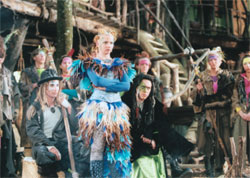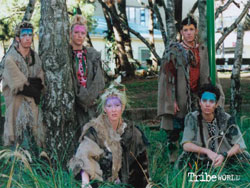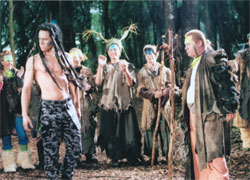 Hemp
Hemp
Your mum may be a bit alarmed when she sees you sporting your new hemp friendship necklace. She, like many people, is making the mistake of confusing your fashion statement with the better-known by-product of the Cannabis sativa plant.
Cannabis is actually an extremely diverse species, with thousands of different strains, each possessing different qualities.
No, you cannot smoke that necklace. (Well, okay, technically, it’s flammable, but the only psychosomatic effect you can expect to experience is a headache from smoke inhalation).
Despite its negative associations with marijuana, hemp is an unquestionably valuable resource.
Hemp is extremely fast-growing (10-20 feet in 4 months alone!), and it easily adapts to a wide range of climates. A hemp crop requires very little effort and uses very few resources, including fertilizer, which is a dangerous pollutant especially to water supplies. Hemp naturally repels weeds and attracts few insects, meaning that a hemp crop does not require pesticides.
Imagine how devastating it must be to toil over a high-maintenance cotton crop, only to have your efforts thwarted by a plague of locusts! Even the biblical plagues are no match for mighty hemp!
Whereas cotton fibers are only 1-2 cm in length, hemp fibers grow to the length of the plant, meaning they are often over 15 feet long! Threads woven of a single hemp fiber are far stronger than cotton threads, which are weakened by the constant joints between fibers.
 Hemp fabrics have wonderful breathing and insulative qualities making it a cool cloth in the summer, and a warm cloth in the winter. Hemp products are very similar to linen.
Hemp fabrics have wonderful breathing and insulative qualities making it a cool cloth in the summer, and a warm cloth in the winter. Hemp products are very similar to linen.
And hemps uses are not limited to clothing. Hemp seeds are a valuable source of protein, fiber and essential oils. Hemp oil is great for your skin.
Hemp paper is extremely efficient—compare the 4 month growth period to the 20-50 years necessary to grow a tree; plus, as crops are quickly replenished, there would be no erosion due to deforestation, and hemp paper uses fewer toxic chemicals than wood-paper.
Hemp oil can even be used to fuel a car! (Woody Harrelson tours in a hemp-powered car.)
In fact, there are over 30,000 known uses for the hemp plant, most of which were in practice for thousands of years before pressure and propaganda from the competing cotton industry made hemp a rarity.
Hemp is non-toxic, non-evasive, biodegradable, and easily renewable. This is exactly what Pride and the Eco-Tribe seek in a maintainable resource. Many of the products that are impossible to find on The Tribe could be easily replaced if Pride could popularize the uses of hemp.
Cotton
You are probably familiar with the qualities of processed cotton. Cotton makes a wonderful fabric. However, as touched upon above, traditional cotton processing is extremely environmentally invasive, and requires excessive use of chemical pesticides. It is difficult, after such an unnatural growth process, to claim that cotton is in any way natural.
To harvest this delicate plant, it is heavily sprayed, sometimes as much as 10 times per season, with pesticides so invasive that, after a few crops, they turn the fields barren.
However, recently farmers have begun to explore organic cotton production.
Organic cotton farming entails a return to a more interconnection-focused understanding of the environment. Organic farmers assert that plants can resist insects, weeds and diseases on their own if they are not previously stressed out by chemical exposure.
 Rather than being viewed as threats, bugs are regarded as part of a natural order. Plant-eating insects are preyed upon by carnivorous insects, and if all goes well and remains in balance crops will not be destroyed by insect plagues.
Rather than being viewed as threats, bugs are regarded as part of a natural order. Plant-eating insects are preyed upon by carnivorous insects, and if all goes well and remains in balance crops will not be destroyed by insect plagues.
Organic cotton growing requires an extremely vigilant eye. In contrast to hemp crops, in cotton farming, insects such as the boll weavel can easily devastate a crop. For organic farmers, insect infestations are seen as indicators that nature is out of balance, and hand labor is necessary in the place of chemicals to restore balance.
While less efficient than hemp, cotton is an extremely comfortable and popular fabric.
Linen
Linen is derived from fibers in the stem of flax (latin: Linen Usitatissimum), a flowering plant about a meter tall. Flax flowers bloom for only a single day. Flax was one of the first agricultural crops cultivated by man, and has been used for textiles for thousands of years.—In fact, linen is the cloth used to wrap mummies in early Egyptian tombs!
Unfortunately, like hemp, flax production was greatly reduced as the cotton industry rose.
Although flax is not a fast-growing crop comparable to Cannabis, linen products, as mentioned above, have similar qualities to hemp.
Unlike cotton, flax cannot provoke allergic reactions. Linen absorbs moisture and humidity without feeling damp and allows skin to breathe. It is extremely durable, and can be washed many times without alteration, and, as it has low elasticity, linen products do not deform over time. Linen actually grows softer with wear.
Flax plants are actually pulled from the ground, rather than cut, making them an ideal product for a non-industrial society.
The actual process of deriving the linen fibers from the flax plant is a bit complicated and time consuming. The plants are deseeded. Next comes the process of retting, in which the plant is deliberately rotted (partially). Retting softens the plant so that it can be scutched (honestly, I’m not making these terms up!) or separated into long fibers (line) and short fibers (tow and shive). The line fibers are then hackled to form sliver, which is spun into threads.
Although it cannot compete with Hemp in this respect, flax has a number of other useful products, such as linseed oil, high-protein livestock feed, and human food
 The EcoTribe Strikes!
The EcoTribe Strikes!
In a world where the manufacturing process no longer exists and the fabric of the past is dwindling day by day, there are two clear options: taking the textile industry back to its origins—or widespread public nudity!
While other factions expend the resources of their parents, cutting up the cloth remnants of their parent’s generations to design beautiful and unique fashion while the resources last, the EcoTribe looks to the future, searching for long-term solutions.
In keeping with the EcoTribe’s desire to preserve the planet, rather than absorbing all resources at once, cotton is not a realistic solution.
Linen, as one of the world’s earliest crops, might prove to be an appropriate choice for Pride and his friends as they begin anew. Although linen requires an intensive process and the EcoTribe is unlikely to find manufacturing manuals for pre-industrial flax refining, it is likely that, with patience, they can figure out a workable process, even if it is different from that of the past. After all, even for the linen that exists today, someone had to figure it out for the first time!
Hemp would make an even better choice for the EcoTribe’s cloth creation, as it is the easiest fiber to cultivate, its high, rapidly growing plants make the best use of time and land, and the cannabis plant can be used in thousands of manners, most of which would prove extremely valuable in a world where resources are scarce.
As is often the case in The Tribe, TribeWorld is an ancient civilization with a memory of its future. The days of cotton have ended. It’s time to come full-circle, and return to the fabric of the past.

